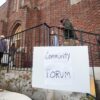By Helen Anne Sweeney and Jan Hauenstein, The Columbus Dispatch
After Michael Frierson became agitated and aggressive on Oct. 4, his sister called 911 to help the 36-year-old diagnosed with schizophrenia experiencing a mental health crisis.
A social worker was busy with another call and could not respond to the request. Even though 911 tagged the call as a mental health incident, police officers responding to the call decided that the incident was a domestic violence dispute.
The officers, who were trained to handle mental health issues, also decided that the incident did not warrant a social worker’s assistance.
The incident ended tragically with Frierson being shot and critically wounded at his mother apartment in the 1600 block of Sullivant Avenue.
Over the next month, the Columbus City Council will make decisions on what programs to fund, including the division of public safety’s non-police alternative response system.
B.R.E.A.D. — Building Responsibility, Equality, and Dignity — and other community-based organizations, such as the Columbus Public Safety Collective, continue to raise questions about this system’s ability to deliver alternative services effectively and efficiently.
Case highlights concerns about system
Our concerns are heightened after the system was unable to respond to Frierson, but we have long pushed for improvements.
Over the last four years, in public hearings and meetings, we have repeatedly asked elected officials and public safety employees to design and implement a comprehensive, community-based non-police alternative system to handle 911 calls needing social services, including behavioral health, food insecurity, and neighbor disputes.
The current system, which is devoid of community input and oversight, relies on police officers and fire fighters to handle on-site, incidents needing social services.
Social workers tend to remain at the 911 call center to de-escalate the situation until police arrive on the scene. Only a small portion of calls receive follow-up services.
How can the non-police alternative response system be fixed?
To create this system, we have asked city officials to hire a consultant, convene a citizen advisory board, and begin a test pilot.
The citizen advisory board is key to the non-police alternative response system being successful since the board would be involved in design, implementation, and on-going oversight of the system. Even though city council allocated $1.7 million in 2023 to fund this request, city officials have not spent any of the funds, resulting in no progress being made on the project.
We also requested that the 911 call center be revamped to handle non-police alternative response calls.
Changes include a process to identify and dispatch non-police alternative response calls. Also, the lack of 911 connectivity to other call centers further splits an already fractured crisis services network, resulting in an inefficient use of resources and confusion among community residents.
Instead, 911 should be connected to other county community service call centers, such as the 988 behavioral health crisis line. Doing so would help Public Safety staff coordinate resources across organizations, possibly preventing situations similar to Mr. Frierson’s.
Other Ohio cities have alternative response system, so should Columbus
According to Franklin County Alcohol, Drug, and Mental Health board officials, the 911 and 988 lines will not be linked for at least another five years.
Other cities, including Cincinnati and Dayton, have started alternative response systems.
Evaluations of the Cincinnati and Dayton systems show promising results. Cincinnati connected the 911 and 988 lines and increased the number of social workers who can handle behavioral health calls. Dayton transfers non-police calls, such as neighborhood disputes, to its mediation center.
If other cities can develop common-sense approaches on handling alternative issues, why can’t Columbus officials adopt a similar systematic approach? We are again calling upon Columbus city officials to build an alternative response system that meets the community’s needs and avoids further tragic, preventable harm to people needing social service assistance.
Helen Anne Sweeney and Jan Hauenstein are members of the B.R.E.A.D. Stop Violence! Build Trust! committee.
View the original story here.






